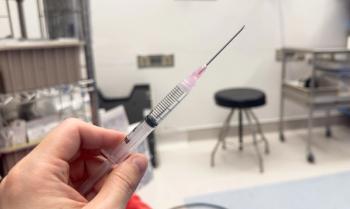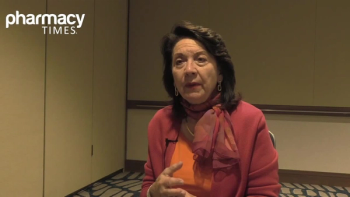Rates of breast cancer are rising at approximately 1% every year.1 In fact, there is a 1 in 8 chance that a woman will get breast cancer in her lifetime, and it is the second-leading cause of cancer death for American women.2 The average age of diagnosis for American women is 62.3 Though rarer, men can also be diagnosed with breast cancer, with 1 in 1000 men diagnosed in their lifetime.4
Breast cancer is a complex condition with many different histological classifications. The most common type is invasive ductal carcinoma. This makes up 70% to 80% of breast cancers. The second most common is lobular carcinoma (10%-15%).5
According to the American Cancer Society, mammogram screening should be considered for all women beginning at age 40.6 Should the mammogram have abnormal results, the provider will do further workup to determine if it is breast cancer. This workup could include further mammography, ultrasonography, breast magnetic resonance imaging (MRI), and biopsy.
The treatment plan for patients with breast cancer is dependent on specific information that was gathered from the patient workup. The cancer will need to be staged using TNM (tumor, node, metastasis) classification. The results of the TNM classification will then be used to assign the patient into a stage group (0-IV). Treatment for patients with breast cancer is dependent on certain qualities of the tumor. The tumor will be further evaluated to determine if it is estrogen receptor positive (ER+), progesterone receptor positive (PR+), or human epidermal growth factor receptor 2 positive (HER2+). If none of the above are present, the tumor is classified as “triple negative.” Several treatment options are available, and it is possible for a combination of treatments to be used to best manage the condition. Treatment options include surgery, chemotherapy, radiation, hormonal therapy, targeted therapy, immunotherapy, and biologic therapy.7
There is some positive news on the breast cancer front. The death rate from breast cancer has decreased by about 10% over the past 10 years.8 The 5-year survival rate is 91.2% and the 10-year survival rate is 84%.9 There are also new targeted therapy drugs on the market to treat the illness, including inavolisib (Itovebi; Genentech, approved in October 2024), capivasertib (Truqap; AstraZeneca. approved in November 2023), and elacestrant (Orserdu; Stemline Therapeutics, approved in January 2023).
Maxor Analysis: Breast Cancer Medication Adherence and Social Determinants of Health
Maxor recently performed a retrospective claims analysison the use of and adherence to CDK 4/6 inhibitors for the treatment of breast cancer.10 CDK 4/6 inhibitors are used to treat hormone receptor-positive HER2-negative metastatic breast cancers.
The analysis covered January 2022 to December 2023 and focused on patients new to therapy after January 1, 2022. The goal was to understand the correlation among social determinants of health (SDOH), lifestyle risk factors, and the treatment and development of more effective, targeted interventions.
SDOH are nonmedical factors that affect health outcomes, according to the Centers for Disease Control and Prevention.10 These can include health care access and quality, education, neighborhood, economic status, race, employment status, social connections, transportation, lifestyle, food security, housing security, health literacy, sexual orientation, immigrant status, environment, and language skills. More than 80% of factors that influence health outcomes are not related to clinical care.11
In the Maxor analysis, medication adherence was assessed using Proportion of Days Covered. The average age of the patient population was 56, and the average adherence of the total population was 86.8%. These SDOH data definitions were included:
- Access to care: remote area, low population ratio
- Digital and health literacy: limited health awareness, low education
- Social isolation: not married, small household size
- Economic stability: less net worth or low income
- Transportation: no access to personal vehicle
The analysis found that the majority of patients over age 65 were at risk for non-adherence. It also found that patients who were non-adherent were more likely to have more SDOH factors. Digital and health literacy was the biggest SDOH factor contributing to non-compliance. Forty percent of the members in the non-adherent cohort were at risk for having a digital or health literacy-related SDOH factor.
These data show us that SDOH matters when treating patients with breast cancer. Furthermore, pharmacists can aid in addressing these challenges during treatment.
The Role of Pharmacists in Treating Patients With Breast Cancer
The pharmacist plays a critical role in breast cancer treatment. Pharmacists can provide patients with education and counseling needed for their oncolytic therapy.12 Because oncology medications are associated with many adverse drug events (ADEs), pharmacists monitor and assess patients for ADEs and help in reducing the risk for those ADEs. Ifpatients experience an ADE, pharmacists can act as valuable partners on the care team to support management and collaboration with providers to discuss next steps.13
Additionally, many oncolytics have significant risks for drug interaction. Pharmacist engagement has been shown to reduce these risks. Pharmacist intervention has also been shown to lead to improved adherence to oral oncolytics, improved patient satisfaction, and improved quality of life.14,15
There are a variety of ways in which SDOH factors can affect cancer care, including breast cancer. Evidence has shown that SDOH risk factors can poorly affect patient outcomes, including mortality.16 The Maxor analysis, for example, showed patients with breast cancer with poor adherence to their medications were likely to have 3 or more SDOH risk factors.
There is a complex interplay between SDOH risk factors and their effect on treatment and outcomes for patients with breast cancer. SDOH can affect the speed at which patients are diagnosed. Patients with transportation issues, socioeconomic risk factors, or insurance challenges may not receive regular recommended screening, which could result in later stage diagnosis. Being diagnosed at a later stage is associated with poorer outcomes.
Across all age groups, socioeconomic status appears to play a significant role in outcomes. Lower socioeconomic status has been linked to an increased risk of breast cancer, late-stage diagnosis, and poorer survival rates.17 Women with lower socioeconomic status may have less access to care and less health literacy, which can contribute to poorer outcomes.
About the Authors
Maria Roberts, PharmD, is director of specialty clinical programs at MaxorPlus.
Angie Oster, PharmD, is vice president of clinical strategy and innovation at MaxorPlus.
Michelle Brisco Fields, PharmD, MBA, MHA, is vice president of clinical analytics and product development at MaxorPlus.
Cara Colodonato, PharmD, is a clinical intervention pharmacist in clinical and product development at MaxorPlus.
Jay Koirala is senior clinical business analyst in clinical analytics and product development at MaxorPlus.
Race and ethnicity also appear to have a significant impact. For example, mortality rates are 40% higher in Black women than in White women.18 American Indian/Alaska Native women have a 51% higher mortality rate than White women (after adjusting for sex, age, and stage at diagnosis).19 Hispanic women have a lower incidence rate of breast cancer than other groups, but it is their number 1 cause of cancer death.20 Asian American women born in the US have approximately the same rate of breast cancer as White women, but Asian American women who have recently immigrated have a lower rate.21
Access to care also plays a key role. Underinsured and uninsured patients are more likely to be diagnosed at a later cancer stage.22 Some women may not have transportation to get them to a clinic or doctor’s office where they can get a mammogram, delaying screening and diagnosis. More SDOH risk factors are also associated with higher risk for comorbidities including hypertension, cardiovascular disease, diabetes, and stroke.23
Because pharmacists are often considered to be the most accessible health care professionals, they are well positioned to help address SDOH factors. Early in therapy, pharmacists can use tools to screen for SDOH risk factors and connect patients with resources to support their needs.24 Some of these resources could include information about financial help, support groups, and transportation assistance. Throughout the course of treatment, it’s important to continue to screen for any updated needs. The cost of care for breast cancer treatment can be substantial, and SDOH needs may change as a result. Patients may have an increased need for financial and emotional support. They may also need assistance navigating changes in their insurance. Because of their accessibility, pharmacists are more poised to support patients throughout therapy and after its completion.
During counseling, it is important for pharmacists to consider SDOH. One factor they must consider is digital and health literacy—they need to make sure patients understand the information being provided to them. The Maxor analysis found that digital and health literacy were the number 1 factor affecting adherence. Treatment for breast cancer can be complicated, so patients need to understand how and when to take their medicine and what they should do if they experience ADEs. Pharmacists should also understand patients’ travel needs, particularly for doctor appointments, infusion clinics, and lab work.
Pharmacists also play an important role in supporting patients to maintain their adherence. It’s crucial to provide personalized counseling to patients to meet their specific needs, understand their concerns, and identify any barriers to adherence. Data suggest that major factors affecting adherence in oncology patients are mistrust in medication therapy and ADEs.25 Pharmacists can provide detailed information to build patient trust and prepare patients for any adverse events that may occur.26 Pharmacists should also make sure that patients understand instructions for taking their medications, report ADEs, and review any supplemental information they receive about treatment.
Pharmacists play a considerable role in treating patients with breast cancer. Not only can they provide counseling and education, but they can also screen for SDOH risk factors and address those during treatment and after its completion. When pharmacists take those factors into account, they provide more targeted and personalized care, which could result in greater adherence, better outcomes, and happier patients.
Disclaimer: The above does not constitute medical advice. Always consult with a qualified and licensed physician or other medical professional.
REFERENCES
Cho A. Breast cancer rates rising highest among Asian American women. NBC Washington. October 7, 2024. Accessed October 8, 2024. https://www.nbcwashington.com/news/health/breast-cancer-rates-rising-highest-among-asian-american-women/3735107/#:~:text=The%20American%20Cancer%20Society%20putting,%2C%20at%202.5%25%20a%20year.
Key Statistics for Breast Cancer. American Cancer Society. Accessed October 8, 2024. https://www.cancer.org/cancer/types/breast-cancer/about/how-common-is-breast-cancer.html
Breast Cancer Facts & Stats. National Breast Cancer Foundation, Inc. August 1, 2024. Accessed on October 8, 2024. https://www.nationalbreastcancer.org/breast-cancer-facts/#:~:text=The%20average%20age%20of%20U.S.,cancer%20is%2062%20years%20old.&text=Half%20of%20U.S.%20women%20who,younger%20when%20they%20are%20diagnosed.&text=About%209%25%20of%20all%20new,younger%20than%2045%20years%20old.
Male Breast Cancer. Susan G. Komen Breast Cancer Foundation. Accessed on October 18, 2024. https://www.komen.org/breast-cancer/facts-statistics/male-breast-cancer/#:~:text=male%20breast%20anatomy.-,Breast%20cancer%20in%20men,in%20the%20U.S.%20%5B220%5D.
Breast Cancer Treatment (PDQ®)- Health Professional Version. NIH, National Cancer Institute. Accessed on October 18, 2024. https://www.cancer.gov/types/breast/hp/breast-treatment-pdq#_18
American Cancer Society Recommendations for the Early Detection of Breast Cancer. American Cancer Society. Accessed on October 18, 2024. https://www.cancer.org/cancer/types/breast-cancer/screening-tests-and-early-detection/american-cancer-society-recommendations-for-the-early-detection-of-breast-cancer.html#:~:text=Women%2045%20to%2054%20should,at%20least%2010%20more%20years.
Treatment of Breast Cancer. Centers for Disease Control and Prevention. Accessed on October 18, 2024. https://www.cdc.gov/breast-cancer/treatment/index.html#:~:text=Treatment%20options,rays)%20to%20kill%20the%20cancer.)
Rabin RC. Breast Cancer Continues to Rise Among Younger Women, Study Finds. The New York Times. October 1, 2024. Accessed on October 8, 2024. https://www.nytimes.com/2024/10/01/health/breast-cancer-young-women.html#:~:text=Breast%20cancer%20incidence%20rose%20by,each%20year%2C%20the%20report%20found.
Stumpf-Sutliff KA. Breast Cancer Survival Rates. WebMD. August 7, 2024. Accessed on October 8, 2024. https://www.webmd.com/breast-cancer/breast-cancer-survival-rates
Hood CH, Gennuso KP, Swain GR, Catlin BB. County Health Rankings: Relationships Between Determinant Factors and Health Outcomes. American Journal of Preventive Medicine. February 2016;50(2). Accessed on October 18, 2024. https://www.sciencedirect.com/science/article/abs/pii/S0749379715005140
Avery M. The Importance of Pharmacist Providing Patient Education in Oncology. Journal of Pharmacy Practice. February 2015;28(1). Accessed on October 17, 2024. https://journals.sagepub.com/doi/10.1177/0897190014562382
Staynova R, Gavazova E, Kafalova D. Clinical Pharmacist-Led Interventions for Improving Breast Cancer Management- A Scoping Review. Current Oncology. July 25, 2024. Accessed on October 17, 2024. https://www.mdpi.com/1718-7729/31/8/312#:~:text=As%20medication%20experts%2C%20pharmacists%20can,ongoing%20adherence%20assessments%20%5B50%5D
Ma Carolyn SJ. Role of pharmacists in optimizing the use of anticancer drugs in the clinical setting. Integrated Pharmacy Research and Practice. February 19, 2014. Accessed on October 17, 2024. https://www.dovepress.com/role-of-pharmacists-in-optimizing-the-use-of-anticancer-drugs-in-the-c-peer-reviewed-fulltext-article-IPRP)
Pinheiro LC, Reshetnyak E, Akinyemiju T, Phillips E, Safford MM. Social Determinants of Health and Cancer Mortality in the Reasons for Geographic and Racial difference in Stroke (REGARDS) cohort study. Cancer. September 3, 2021. Accessed on October 17, 2024. https://pmc.ncbi.nlm.nih.gov/articles/PMC9301452/
Nadeau M, Best LG, Klug MG, Wise K. Exploring Clinical Risk Factors for Breast Cancer Among American Indian Women. Frontiers in Public Health. June 17, 2022. Accessed on October 17, 2024. https://pmc.ncbi.nlm.nih.gov/articles/PMC6941147/
Breast Cancer Facts & Stats. National Breast Cancer Foundation, Inc. August 1, 2024. Accessed on October 17, 2024. https://www.nationalbreastcancer.org/breast-cancer-facts/#:~:text=The%20average%20age%20of%20U.S.,cancer%20is%2062%20years%20old.&text=Half%20of
Yedjou CG, Sims JN, Miele L, et al. Health and Racial Disparity in Breast Cancer. Advances in Experimental Medicine and Biology. 2019. Accessed October 17, 2024. https://pmc.ncbi.nlm.nih.gov/articles/PMC6941147/
Gehlert S, Hudson D, Sacks T. A Critical Theoretical Approach to Cancer Disparities: Breast Cancer and the Social Determinants of Health. Frontiers in Public Health. May 20, 2021. Accessed on October 17, 2024. https://www.frontiersin.org/journals/public-health/articles/10.3389/fpubh.2021.674736/full
Pinheiro LC, Reshetnyak E, Akinyemiju T, Phillips E, Safford MM. Social Determinants of Health and Cancer Mortality in the Reasons for Geographic and Racial difference in Stroke (REGARDS) cohort study. Cancer. September 3, 2021. Accessed on October 17, 2024. https://pmc.ncbi.nlm.nih.gov/articles/PMC9301452/
Mitkova Z, Karanyotova S, Arabadijev J, Radichev N, Pancheva G, Dimitrova M. Role of pharmacists on adherence in oncology patients. Biotechnology & Biotechnical Equipment. 2024. Accessed on October 17, 2024. https://www.tandfonline.com/doi/full/10.1080/13102818.2024.2359000#abstract




















































































































































































































